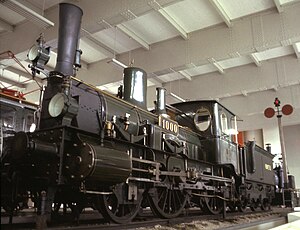Bavarian B IX
| Bavarian B IX DRG Class 34.74 | |||||||||||||||||||||||||||||||||||||||
|---|---|---|---|---|---|---|---|---|---|---|---|---|---|---|---|---|---|---|---|---|---|---|---|---|---|---|---|---|---|---|---|---|---|---|---|---|---|---|---|
 Bavarian B IX "1000" in the Deutsches Museum | |||||||||||||||||||||||||||||||||||||||
| |||||||||||||||||||||||||||||||||||||||
| |||||||||||||||||||||||||||||||||||||||
| |||||||||||||||||||||||||||||||||||||||
| |||||||||||||||||||||||||||||||||||||||
The B IXs of the Royal Bavarian State Railways (Königlich Bayerische Staatsbahn), built from 1874, were the first express train locomotives in Bavaria. (N.B. The engines described here are not to be confused with the B IX steam engines built in 1870 and described under Bavarian B IX (1870).)
As a result of the boiler being positioned low and the rear driving axle being under the outer firebox there was no longer any overhanging weight and the speed of the engine could be increased to 90 km/h. The locomotive could also haul a 150-ton train on the level at a speed of 70 km/h. The engines, retaining the design of their forerunners, had an outside locomotive frame and Stephenson valve gear. The units taken over by the Reichsbahn were run under the operating numbers 34 7421–7440. The locomotives built from 1874 were retired by 1924.
At the Deutsches Museum in Munich a sectioned example has been preserved. Parts of the collection, including the B IX, are stored in the Freilassing Locomotive World (Lokwelt Freilassing) museum in Freilassing due to a shortage of space.
The vehicles were coupled to Bavarian 3 T 10,5 tenders.
